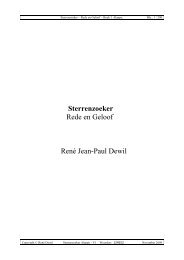A visual Journey into the Bible The Book of Genesis
A visual Journey into the Bible The Book of Genesis
A visual Journey into the Bible The Book of Genesis
You also want an ePaper? Increase the reach of your titles
YUMPU automatically turns print PDFs into web optimized ePapers that Google loves.
A Visual <strong>Journey</strong> <strong>into</strong> <strong>the</strong> <strong>Bible</strong> Page: 24<br />
Chapel, <strong>the</strong> Pauline Chapel and finally <strong>the</strong> ‘Last Judgement’ <strong>of</strong> <strong>the</strong> Sistine Chapel. He<br />
also wrote sonnets and poems, some <strong>of</strong> which were love poems to Vittoria Colonna,<br />
<strong>the</strong> Marchese de Pescara.<br />
Michelangelo appears to us as a tower <strong>of</strong> a man, an all-genius artist, architect and<br />
engineer such as <strong>the</strong> world has not seen after him. He was a man who could do<br />
everything, a shaper <strong>of</strong> civilisation. He was impregnated with <strong>the</strong> spirituality <strong>of</strong><br />
Roman Catholic religion, but he added a new dimension: <strong>the</strong> power <strong>of</strong> man, and <strong>the</strong><br />
confidence, <strong>the</strong> triumph <strong>of</strong> man’s deeds.<br />
Adam and Eve<br />
Lucas Cranach <strong>the</strong> Elder (1472-1553). <strong>The</strong> Courtauld Institute Galleries - London.<br />
Ca.1526.<br />
<strong>The</strong> Italian Renaissance had started around 1400 in Italy, even though <strong>the</strong> first<br />
pictures <strong>of</strong> its sparkle came a quarter <strong>of</strong> a century later. From Italy <strong>the</strong> new ideas<br />
moved northward. Thus it reached Germany earlier than Flanders, Brabant and<br />
Holland maybe because <strong>the</strong> Gothic tradition was stronger and more brilliant in <strong>the</strong>se<br />
last regions. Albrecht Dürer (1471-1528) and Lucas Cranach <strong>the</strong> Elder (1472-1553)<br />
were contemporaries. Dürer was totally open to international ideas in art and<br />
philosophy. He was a traveller. He went twice to Italy to study art and confer with<br />
Italian artists. He also went to Flanders and Holland. His style was courteous, refined,<br />
complex and delicate. But he was also a passionate man and a man who doubted and<br />
was uncertain <strong>of</strong> himself at times. His terrible engravings <strong>of</strong> <strong>the</strong> Apocalypse prove<br />
this. Dürer was <strong>the</strong> intellectual <strong>of</strong> <strong>the</strong> two. Lucas Cranach <strong>the</strong> Elder was more linked<br />
to his region. Cranach never travelled to Italy. He was rooted in popular German art,<br />
German character and morals. He perpetuated <strong>the</strong> spirit <strong>of</strong> <strong>the</strong> German soil. He knew<br />
<strong>the</strong> splendour <strong>of</strong> <strong>the</strong> Renaissance. He painted mythological scenes, especially his<br />
sensual Venuses. He knew <strong>the</strong> Renaissance’s glorification <strong>of</strong> <strong>the</strong> human body but he<br />
did not want to leave <strong>the</strong> tradition <strong>of</strong> old to seemingly naively paint stylised images.<br />
He made a gradual transition to Renaissance, whereas Dürer jumped without nei<strong>the</strong>r<br />
bonds nor complexes nor restraint immediately <strong>into</strong> <strong>the</strong> new vision.<br />
Lucas Cranach <strong>the</strong> Elder painted an ‘Adam and Eve’ around 1526, after an etching <strong>of</strong><br />
Dürer. U4. Cranach used Dürer’s poises in several pictures. We notice <strong>the</strong> grace <strong>of</strong><br />
Dürer, and his freedom in composition as compared to earlier Gothic, as well as<br />
Cranach’s links with traditional German representation clearly in this picture. In<br />
Cranach’s picture man and woman are indeed <strong>the</strong> focus <strong>of</strong> attention and landscape is<br />
still in <strong>the</strong> background, as one would expect <strong>of</strong> Renaissance and Gothic painters.<br />
Adam and Eve are pictured in attitudes that explain <strong>the</strong> scene <strong>of</strong> <strong>the</strong> <strong>Bible</strong>. Eve is still<br />
grasping a branch <strong>of</strong> <strong>the</strong> Tree <strong>of</strong> Knowledge and in a gesture fur<strong>the</strong>r in time hands<br />
over <strong>the</strong> apple to Adam. Her poise is coquettish and her long legs show some <strong>of</strong> <strong>the</strong><br />
sensuality <strong>of</strong> <strong>the</strong> spectator-artist Cranach. Yet, her forms remain spiritualised in a<br />
restraint that is respectful as necessary for a religious scene. Eve’ forms are barely<br />
accentuated by shadows; her body is <strong>the</strong> pale colour <strong>of</strong> a fleshless symbol. Cranach<br />
showed more distance than <strong>the</strong> bold Dürer. Adam accepts <strong>the</strong> apple but he scratches<br />
Copyright ©: René Dewil Date: October, 24 2000











